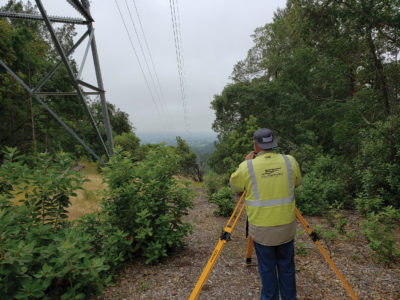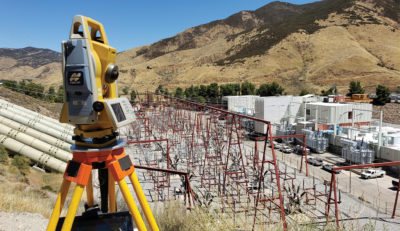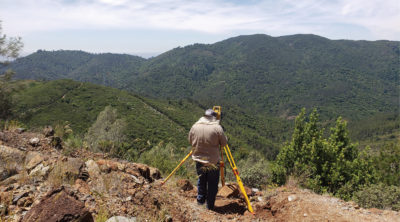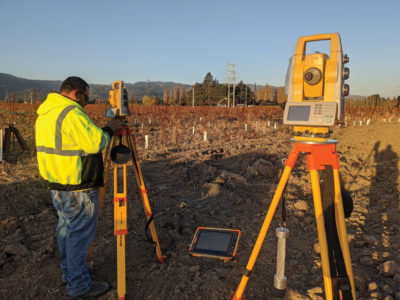
On a project in Sonoma county for PG&E, James Neill, one of Surefire’s newest QA/QC line inspectors, uses a total station to conduct a line sagging operation.
The numbers are pretty impressive: in the U.S. alone, it takes more than 200,000 miles of high voltage transmission lines (eight times the circumference of the Earth) and 5.5 million miles of local distribution lines (24 trips to the moon and back) to power our daily lives.
The lines are seemingly everywhere, and maintaining that grid—which includes everything from stringing new line to repairing existing ones to periodic measurement of key components—can be a herculean task. The measurement and documentation components of that list are two of Surefire Consulting’s key specialties and, by embracing the use of robotic total stations, the company has streamlined that process, improved on-site safety and dramatically raised the accuracy of the product it presents its customers. Guaranteed: that is no line.

At a substation for Los Angeles Dept. of Water & Power, Surefire’s preliminary surveying efforts establish distance measurements to calculate the length of line needed to reach from one of the towers into the substation.
Surefire Startup
Based out of Temecula, Calif., Surefire Consulting is the brainchild of Frank Flores who, along Chad Lueck, Randy Allred and Mark Ramos, was working as an inspector on a project called DPV2 when inspiration to strike out on his own hit him.
“The full name of that job was Devers/Palos Verdes Circuit 2 and it involved construction of more than 180 miles of new transmission line,” said Ramos, one of Surefire’s current principals. “Even though each of the four of us had different roles in that project, we all had a similar drive, shared the same vision for where we wanted our careers to go, etc. It didn’t happen immediately, but in 2006 when Frank called to say he was starting his own company, we committed without hesitation. It was obvious to us all that he understood the hoops we had to jump through working under these large contract managers and, just as importantly, knew what needed to be done better.”
To be clear, the functions each of the men performed differed, but included work measuring sag on the transmission lines themselves, effects upon the tower structures, placement of the foundations, etc. Collectively, however, it was all done in support of a contract manager—or managers—who, in turn, worked for the utility. “Frank saw the potential we all had to do the job better and acted on it,” said Ramos. “I, personally, could not pass up the chance to get in on the ground floor of something this exciting—obviously Chad and Randy felt the same way.”

A view through the sight of the Topcon IS-3 on a sagging operation in the California desert in which an original line was being reconductored.
Looking to Grow
Fast forward to the present and the Surefire Consulting of 2019 is an established, minority-owned, fully-integrated construction management and technical service company. With specialties in providing quality control and quality assurance (QA/QC) inspection for utilities throughout the state, the company currently has nine employees and is poised for additional growth.
“We are actively looking to hire at least two or three additional personnel and feel that is just the start,” said Ramos. “There are some very big names in California power distribution—some of whom we are already doing work for in a different capacity—who are interested in what we do and how we do it. Because we are still a relatively small company, that could be a huge step for us.”
Small size notwithstanding, Surefire benefits from being a union shop—working through locals in both southern and northern California—and being certified as both a Small Business Enterprise and a Minority Business Enterprise.

Surefire’s Juan Rivera (left) and James Neill (right). Rivera is a journeyman lineman who, despite a proven specialty in the construction of steel towers, has shown an interest in learning the surveying aspect of the job.
Have Gun, Will Travel
While the Surefire crew knew the things they needed to do differently with their newly-formed company, they also embraced what had worked for them in the past. Using total stations for asset measurement easily topped that list. Working through Chad Dickey and TopoElement, the local Topcon dealer, Flores, Ramos, et al, upped that performance capability with Topcon robotic total stations, FC-2500 field controllers and the software to gather their data. Doing so, said Ramos, truly separated them from the pack.
“Right out of the gate, we were able to generate a product that showed contractors that we were far different from anyone else they might have worked with in the past,” said Ramos. “Chad Dickey was able to help us hit the ground running and, to this day, has provided outstanding support to us. Most of the jobs we focus on are still, to a large extent, either being done using outdated manual techniques or using equipment that is lacking in precision. Using our Topcon guns we are able to offer a level of quality and precision that definitely turned heads.”
He added that each of the four men involved in the startup already had a familiarity with the Topcon line, having used non-robotic models with their previous company on some line sagging work. However, they quickly discovered that the newer robotic solutions far outperformed even those units.

James Neill in the Napa Valley forest area on a sagging operation for PG&E. Using the total station, he is able to verify whether or not minimum phase-to-ground clearances are being maintained in order to be compliant with federal regs.
Confidence Booster
In a perfect world, we would be able to compare similar products head to head to objectively decide if we’d made the right purchase decision. Ramos said they’ve had several opportunities to do just that to prove the advantages the newer Topcon solutions bring to a jobsite and have not been disappointed.
“We were working alongside a crew that was using a different total station in a sagging operation,” said Ramos. “The contractor, apparently lacking total confidence in them, asked us to double check their work. So I went out and met with that crew and saw that they were having trouble catching the conductor to get the shot. We set up the IS-3 and were able to nail every shot—with far greater accuracy—every time. We presented our work to the customer who looked at our numbers and promptly told us to finish out the job.”
The solution used on that project, the Topcon IS-3, is a robotic total station that provides Surefire with the power, accuracy, and speed of a total station, and then supplements that with the auto-scanning capabilities of a laser scanner. In applications like the one described above, Topcon’s IS-3 provides a powerful and cost effective alternative to laser scanning.
“The methods used by many others in this business can be precise but their results are based on the user and their eye,” added Ramos. “By comparison, the Topcon system we use—and the software that drives it—gives us a level of precision that’s just absolutely beyond compare.”

In preparation for installation of marker balls — plastic spheres installed on power lines to improve their visibility to aircraft — Rivera gets instruction from Ramos on the use of the Topcon data collector and total station.
Deflecting Doubt
Surefire’s ability to accurately record such details has paid off in other areas as well. In the case of measuring tower deflection (the movement of an object away from its normal position), it has particularly excelled. According to Ramos, a recent project to replace wooden poles with steel ones is a perfect case in point.
“We were at Camp Pendleton in San Diego County working with a contractor who was “fire-hardening” the site so that, in case of wildfires, the poles wouldn’t burn and the conductors would be safe. The new poles had to be reset within a level of 1.96% deflection, so each pole had to be almost perfectly plumb.”
The contractor in charge of the Camp Pendleton project was particularly concerned about a number of poles that had already been re-set using a different system and asked Surefire’s crew to re-check them.
“We went out, did our deflection checks and found that, when the sun would shine on the metal poles, one side would heat but the other wouldn’t, resulting in expansion/contraction and movement of the pole. The utility initially doubted our numbers, but I set up the IS-3 and tracked the pole’s movement for an entire day. When I showed them the numbers indicating how it would go from in-tolerance, to slightly out, then back in later in the evening, they believed it—and they believed in us. We simply couldn’t have proved that without the Topcon solution.”
Disaster Response
While most of Surefire Consulting’s work remains unseen by the general public, occasionally a high-profile project comes about. The Oroville Dam rerouting was one of those. In 2017, when heavy rains and the resultant flooding damaged the main spillway at the dam, plans were set in place, first to ensure the safety of area residents, then to make certain that electric power to the area—including Sacramento—was not disrupted. Working with contractor Barnard Construction, Surefire’s crew helped with construction of 22 new towers and the re-routing of 13,500 linear feet of line from the base of the dam across the Feather River (several times) before rejoining existing lines.
“Those original lines ran directly across the spillway, so it was critical that the integrity of the system remained intact,” said Ramos. “Barnard first set up a temporary line away from areas that were threatened by erosion from water leaving the spillway, and then set to work on construction of the rerouted permanent line. Everything was obviously fast-tracked and the Topcon solutions we brought to the table helped streamline the QA/QC facts of the job.”
Surefire’s work included placement of footings for the towers being constructed. Each tower consisted of footings set up in four separate quadrants. To ensure placement accuracy, the Surefire crew set up the Topcon total station, took a shot to a reference point and was able to tell with absolute precision, the distance to each of the four corners.
“The tolerances on these structures are extremely tight— anywhere from .1 to .05—so you need an instrument that can give you that level of accuracy and precision each and every time. That’s exactly what we bring. We were proud to have worked on a high-profile project like Oroville and know that we played a role in helping deal with an extremely serious situation. The solutions—and results—we bring to a project like that speak for themselves; the agencies for which we work have learned that we can provide the goods.”
Path to Growth
The team at Surefire agrees that steady growth is the way to go, provided they are able to maintain the level of quality they are providing now. So, with an eye toward a controlled increase in business, they are enhancing their status with contractors—and major utilities—throughout the state.
“We all love what we do and are excited to be part of a business that proves its value every day,” said Ramos. “Topcon is a big part of what we do, and Chad Dickey and TopoElement are a key part of the support system, so we are covered in that area, for sure. The work we do can be challenging, but we have already seen that we have the people and the technology we need to take Surefire forward. When asked what Surefire does, I sometimes struggle to accurately describe it. But a contractor we worked for might have summed it up best when he said: ‘You guys are cheap insurance to me.’ He saw the work we did as a way of ensuring there were no surprises—we can live with that description.”